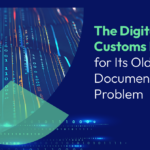Let’s face it: the tools customs authorities rely on to verify trade documents haven’t kept up with the times. Whether it’s a packing list or a bill of lading, the process of checking if a document is genuine is full of uncertainty and far from reliable.
The core issue: no way to know if a document is authentic
Most trade documents arrive as PDFs by email. That’s convenient, but it also means there’s no real proof of origin, no way to confirm who sent the file, and no guarantee the content hasn’t been changed somewhere along the way.
This creates a series of problems for customs:
- No chain of custody: Documents pass through many hands before reaching customs, often without reliable records.
- No built-in authenticity: It’s too easy to forge or edit email attachments.
- Lack of visibility into the source: Customs usually get documents from importers, not directly from the original sender, so it’s hard to trace them back to the exporter and check if they are accurate.
In light of all this, customs have no choice but to rely on trust, visual inspections, and inconsistent or only partly effective verification methods. This is hardly ideal in a global system vulnerable to fraud and manipulation.
The risks: under-invoicing, product swapping, and regulatory gaps
Because of these gaps, customs must deal with:
- Under-invoicing, where the declared value is lower than the actual value to reduce tax liability.
- Over-invoicing, which can be used to claim inflated VAT refunds or export subsidies.
- Mismatched cargo, where the goods listed on the documents don’t reflect what’s actually inside the container.
All of these make it harder to make sure the rules are followed and taxes are collected. They’re hard to detect without better tools for document verification, and checking for them causes delays.
What’s needed: verified documents with a traceable chain of ownership
To address this, we at WaveBL created a blockchain-based digital system that goes beyond simple file sharing. (We’ll explain the blockchain connection in a moment.)
The goal isn’t just to digitize documents, but to create a verifiable chain of actions that shows:
- Who created or signed each document
- When and where it was issued
- Whether it’s been modified or replaced
- That a given document is the one true original
This kind of traceability creates the clearest picture of each transaction, giving customs a truly reliable way to check authenticity without chasing down paper trails or relying on third-party declarations.
A new model
- Registered email with blockchain-backed event logs
We built a registered email system that looks and works like regular email, but with one key difference: every document and envelope gets its own unchangeable event log stored on the blockchain.
This means once a document is uploaded, the system checks its details on the blockchain – like who signed it, when, and from which company – and locks that information in place. After that, the document can’t be changed, and anyone who receives it knows it’s the original source.
This approach keeps things simple and familiar for users while adding a layer of security and transparency that’s missing from typical emails and PDFs.
- Digital envelopes with built-in verification
Our system uses secure digital envelopes that hold trade documents and track all related activity – uploading, signing, transferring, and receiving. These envelopes can’t be changed after the fact, and every action is recorded.
Here’s where it gets interesting: the system uses blockchain – not to create cryptocurrency, but to make the activity history unchangeable and completely secure.
This way, when a document arrives, customs can instantly confirm its authenticity by checking:
- If it was digitally signed by a known entity (e.g. the exporter)
- Whether the file has been replaced or altered
- And whether it’s still the original or a copy
A built-in certificate confirms the status of the document – no need to contact the shipping line or dig through email threads to verify.
- Bank-like Know Your Customer (KYC) process
To make sure only verified parties participate, we also offer a KYC process, similar to what banks use, where exporters register through customs portals and confirm company details. This extra step helps customs trust the source behind every digital document they receive.
What a verified trade document flow looks like
All transactions, documents, and data are secured with blockchain-based technology. Each party can do everything they need in one digital space:
- Exporter
Sends digital documents through the platform, which can include commercial documents, invoices, certificates of origin, export permits, and more.
- Importer
Receives signed and verified documents. Can also upload any needed supporting documents like import permits, health certificates, and more.
- Customs
Receives verified, signed documents with real-time ownership status.
- Confirms shipment origin, exporter details, and document integrity
- Verifies documents in real time using a Certificate of Authenticity (CoA)
- Or gets verification directly through the national customs or trade portal (via API)
Quietly closing a big gap
This smart system quietly removes one of the biggest blind spots for customs: uncertainty about document authenticity.
It’s a practical shift with wide implications: better fraud detection, fewer delays, more accurate revenue collection, and less need for physical archiving.
For customs authorities handling thousands of documents every day, this is a much-needed upgrade to the infrastructure of trust.



